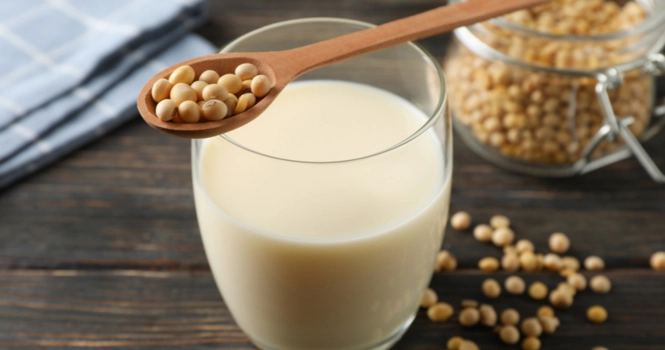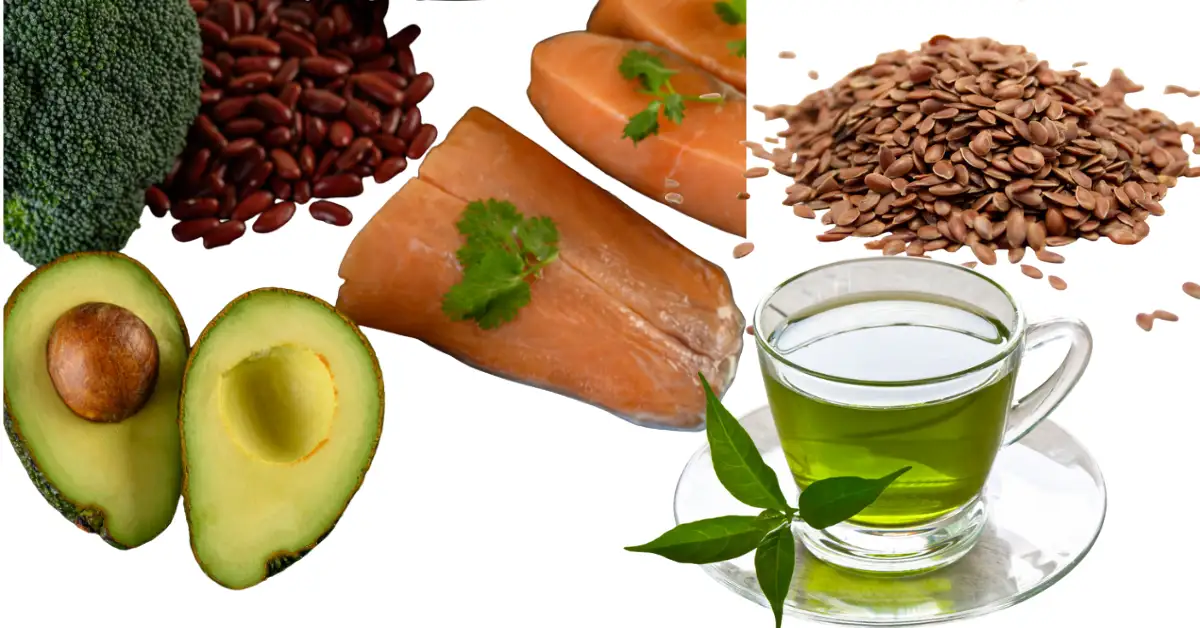Soy Milk: A Healthy and Lactose-Free Dairy Alternative

Soy milk, a plant-based beverage derived from soybeans, has become a staple in the diets of many around the world, appreciated for its nutritional benefits, versatility, and role as a dairy alternative. Its rise in popularity is attributed to increasing health consciousness, dietary restrictions, and environmental considerations.
Overview and Its Rise in Popularity
It is produced by soaking, grinding, boiling, and straining soybeans. The result is a smooth, creamy liquid with a mild flavor, which can be fortified with vitamins, minerals, and flavors to enhance its nutritional profile and taste.
Over recent years, soy milk has seen a significant rise in popularity, particularly in Western countries. This surge is largely due to the growing awareness of lactose intolerance, the rise of vegan and vegetarian diets, and the expanding body of research supporting the health benefits of soy.
Additionally, the environmental appeal of plant-based diets has spotlighted soy milk as a sustainable alternative to dairy milk.
Historical Context and Origins
The origins of soy milk can be traced back to China, where it has been a dietary staple for centuries. Historical records suggest that soy milk and other soy products like tofu were consumed in China as early as the Han dynasty (202 BC – 220 AD). The traditional method of making soy milk involves soaking soybeans overnight, grinding them with water, and then boiling the mixture. The resulting liquid is then strained to produce soy milk.
In traditional Chinese medicine and cuisine, soy milk is valued not only for its nutritional content but also for its versatility. It can be consumed on its own, sweetened, or used as a base for other dishes.
The spread of soy milk from East Asia to other parts of the world began in the early 20th century, but it wasn’t until the latter half of the century that it gained significant popularity in Western countries.
As health and environmental concerns have become more prominent, soy milk has emerged as a key player in the shift towards plant-based diets. Its long history, combined with modern manufacturing and fortification techniques, has made soy milk a widely accepted and nutritionally valuable part of global diets.
Nutritional Profile
It stands out for its balanced nutritional composition, making it a favored alternative to dairy milk and other plant-based milks. Here’s a detailed look at its nutritional profile:
Macronutrients
- Protein: It is one of the few plant-based milks with a protein content comparable to dairy milk. A typical 1-cup serving contains about 6 to 8 grams of protein, which is essential for muscle repair, growth, and various bodily functions.
- Carbohydrates: It contains carbohydrates, with a 1-cup serving offering approximately 4 to 6 grams. The carbs in soy milk mainly come from natural sugars and dietary fiber, which can aid in digestion and provide a steady energy source.
- Fats: The fat content in soy milk can vary depending on the product (e.g., light, unsweetened, or fortified versions), but it generally contains about 2 to 4 grams per cup. Soy milk’s fats are mostly unsaturated, including beneficial omega-3 and omega-6 fatty acids, which support heart health.
Vitamins and Minerals
It is often fortified with vitamins and minerals to enhance its nutritional value, including:
- Calcium and Vitamin D: Fortified soy milk can provide a calcium and vitamin D content comparable to dairy milk, supporting bone health.
- Vitamin B12: Often added to plant-based milks, vitamin B12 is crucial for nerve function and the production of DNA and red blood cells.
- Potassium: It naturally contains potassium, which is vital for heart and kidney function, muscle contraction, and nerve transmission.
- Riboflavin (Vitamin B2) and Vitamin B6: These vitamins are important for energy metabolism and various cellular processes.
Comparison with Dairy Milk and Other Plant-Based Milks
Dairy Milk: Soy milk’s protein content closely mirrors that of dairy milk, making it a strong alternative for those seeking plant-based options. However, dairy milk naturally contains higher levels of calcium and vitamin D, unless the soy milk is fortified. Dairy milk also has more saturated fat and cholesterol compared to soy milk.
Other Plant-Based Milks: Compared to almond, rice, oat, and coconut milks, soy milk generally offers more protein, making it a more nutritionally equivalent alternative to dairy milk.
While almond milk may be lower in calories and coconut milk richer in medium-chain triglycerides (MCTs), they typically provide less protein. Oat milk can offer a higher carbohydrate content, beneficial for energy, but still falls short on protein compared to soy milk.
Health Benefits of Soy Milk
It offers a variety of health benefits, making it an attractive choice for many, especially those looking for plant-based alternatives to dairy. Here’s how soy milk can contribute to overall wellness:
Heart Health and Cholesterol Levels
- Lower Cholesterol: It contains no cholesterol and is low in saturated fat. Studies have shown that incorporating soy protein into your diet can help reduce levels of LDL (bad) cholesterol and potentially lower the risk of heart disease.
- Healthy Fats: The unsaturated fats, including omega-3 fatty acids in soy milk, contribute to cardiovascular health by supporting healthy cholesterol levels and reducing inflammation.
Bone Health and Calcium Absorption
- Calcium-Fortified: Many brands of soy milk are fortified with calcium, making it comparable to dairy milk in terms of calcium content. Calcium is essential for maintaining strong bones and teeth.
- Vitamin D Fortification: Alongside calcium, fortified soy milk often contains vitamin D, which enhances calcium absorption and bone health. Adequate vitamin D levels are crucial for optimizing bone density and preventing osteoporosis, especially in older adults.
Potential Benefits for Certain Populations
- Postmenopausal Women: It is rich in isoflavones, a type of phytoestrogen that can mimic the effects of estrogen in the body. For postmenopausal women, who experience a natural decline in estrogen levels, consuming soy milk may help alleviate menopausal symptoms and provide some protective effects against osteoporosis.
- Individuals with Lactose Intolerance: For those who are lactose intolerant, soy milk offers a lactose-free alternative to dairy milk, enabling them to enjoy milk-like products without the discomfort associated with lactose intolerance.
- Vegans and Vegetarians: It provides a high-quality protein source for individuals following vegan or vegetarian diets, ensuring they receive essential amino acids necessary for various bodily functions.
- People with a Risk of Heart Disease: The heart-healthy profile of soy milk, including its potential role in cholesterol management, makes it a beneficial choice for individuals looking to reduce their risk of heart disease.
It’s important to note that while soy milk can offer these health benefits, individuals should consider their overall dietary pattern and lifestyle for maximum health impact.
A balanced diet, regular physical activity, and other healthy lifestyle choices play a significant role in maintaining wellness. For those with specific health conditions or dietary concerns, consulting with a healthcare professional or a registered dietitian can provide personalized advice and recommendations.
Soy Milk and Allergies
While it is a nutritious and popular dairy alternative, it’s important to address concerns related to soy allergies and sensitivities. Understanding how to identify and manage soy intolerance is crucial for those affected.
Addressing Soy Allergies and Sensitivities
- Soy Allergy Recognition: Soy allergy is more common in infants and children, though most outgrow it by adulthood. Symptoms can range from mild (rashes, hives, itching, gastrointestinal discomfort) to severe (trouble breathing, swelling of the throat and mouth, anaphylaxis). If you suspect a soy allergy, it’s crucial to consult an allergist for testing and diagnosis.
- Sensitivity vs. Allergy: Sensitivity to soy doesn’t involve the immune system and is less severe than an allergy. Symptoms of soy sensitivity might include bloating, gas, or indigestion. Managing sensitivity involves monitoring and adjusting soy intake to levels that do not cause discomfort.
How to Identify and Manage Soy Intolerance
- Reading Labels: Soy is present in many foods, including soy milk, tofu, tempeh, and many processed foods. It’s essential to read labels carefully, looking for soy in all its forms (soy protein, soy lecithin, etc.) to avoid unintentional consumption.
- Soy-Free Alternatives: For those with soy allergies or sensitivities, numerous non-soy milk alternatives are available, such as almond milk, rice milk, oat milk, and coconut milk. Each alternative offers different nutritional profiles and flavors.
- Dining Out: When eating out, it’s important to communicate any soy allergies or sensitivities to the staff. Many restaurants can accommodate such dietary restrictions by offering soy-free options or modifying dishes.
- Allergy Action Plan: For individuals with severe soy allergies, having an allergy action plan in place is crucial. This may include carrying antihistamines or an epinephrine auto-injector (EpiPen) and wearing medical identification that notes the allergy.
- Consultation with Healthcare Professionals: Working with an allergist or dietitian can help in managing a soy allergy or sensitivity. They can provide guidance on safe food choices, reading labels, and ensuring nutritional needs are met despite eliminating soy from the diet.
Awareness and careful management of soy intake are key for those with soy allergies or sensitivities. With a variety of alternative products available and increased labeling regulations, individuals can maintain a balanced and safe diet without soy.
Environmental Impact and Sustainability
The environmental footprint of soy milk is generally considered to be lower than that of dairy milk, reflecting broader trends towards more sustainable food production and consumption.
Comparison of the Environmental Footprint of Soy Milk with Dairy Milk
- Greenhouse Gas Emissions: Dairy milk production is associated with higher greenhouse gas emissions compared to soy milk. Cows produce methane, a potent greenhouse gas, during digestion. The overall carbon footprint of dairy farming, including feed production, land use, and cow emissions, is significantly higher than that of soy cultivation for soy milk.
- Water Usage: Dairy farming is water-intensive, requiring large quantities for animal hydration, feed cultivation, and farm operations. Soy milk production uses less water, even when considering the water required for soybean cultivation. The water footprint of soy milk is notably smaller, making it a more water-efficient option.
- Land Use: Producing soy milk generally requires less land than dairy milk. The efficiency of plant-based protein production allows for more sustainable land use and potentially less deforestation and habitat disruption, particularly when soybeans are grown in existing agricultural areas rather than expanding into new regions.
The Role of Soy Cultivation in Sustainable Agriculture
- Crop Rotation and Soil Health: Soy cultivation can be part of sustainable agricultural practices through crop rotation. Rotating soybeans with other crops can improve soil health, reduce pest and disease cycles, and decrease the need for chemical inputs.
- Nitrogen Fixation: Soybeans have the ability to fix atmospheric nitrogen into the soil through symbiotic relationships with bacteria. This natural fertilization can reduce the need for synthetic nitrogen fertilizers, lowering environmental impact.
- Reduced Dependence on Animal Agriculture: By providing a high-quality plant-based protein alternative, soy cultivation for products like soy milk can help reduce reliance on animal agriculture, aligning with goals for more sustainable food systems.
- Concerns and Considerations: It’s important to note that not all soy cultivation practices are sustainable. Issues such as deforestation, particularly in sensitive ecosystems like the Amazon rainforest, and the use of genetically modified organisms (GMOs) and pesticides, raise environmental and ethical concerns. Choosing soy milk and soy products from sources that prioritize sustainable, non-GMO, and organic farming practices can help mitigate these concerns.
Overall, soy milk presents a more environmentally friendly alternative to dairy milk, contributing to the sustainability of food systems. Consumers can further support sustainability by choosing products that adhere to responsible agricultural and production practices.
Culinary Uses of Soy Milk
It’s versatility makes it a popular choice for cooking and baking, offering a plant-based alternative to dairy milk that can be used in a wide range of dishes. Here are some insights into how to incorporate soy milk into your culinary endeavors:
How Soy Milk Can Be Used in Cooking and Baking
Beverages: It can be enjoyed on its own, in smoothies, or as a base for hot beverages like coffee and tea. It froths well for lattes and cappuccinos.
Breakfast Dishes: Use soy milk in breakfast cereals, oatmeal, or pancakes for a nutritious start to the day. It also works well in French toast batter.
Soups and Sauces: It can serve as a creamy base for soups, chowders, and sauces. Its mild flavor complements a variety of ingredients and spices.
Baking: In cakes, cookies, and muffins, soy milk can replace dairy milk one-to-one, providing moisture and contributing to the overall structure of baked goods.
Desserts: Puddings, custards, and ice creams can be made with soy milk for dairy-free dessert options.
Tips for Substituting Soy Milk for Dairy Milk in Recipes
- One-to-One Ratio: Soy milk can typically be substituted for dairy milk in equal amounts in most recipes.
- Acidic Ingredients: If a recipe involves acidic ingredients like lemon juice or vinegar, ensure that the soy milk is well-stirred and not curdled before use.
- Heat Sensitivity: When cooking or baking with soy milk, avoid high heat to prevent curdling. Gentle heating and frequent stirring can help maintain a smooth consistency.
- Flavor Considerations: Plain soy milk has a subtle, nutty flavor that works well in most dishes, but it’s essential to consider flavor compatibility, especially in delicate or lightly flavored recipes.
Flavor Variations and Enhancements
- Sweetened or Flavored Soy Milk: Available in varieties such as vanilla, chocolate, and almond, flavored soy milk can add an extra dimension to desserts and beverages. Be mindful of added sugars and adjust other recipe ingredients accordingly.
- Homemade Soy Milk: Making it at home allows for complete control over flavor and sweetness. You can add vanilla extract, cocoa powder, or sweeteners like dates or maple syrup to tailor the taste to your preference.
- Savory Dishes: Enhance the savory character of soy milk in soups and sauces by adding nutritional yeast, herbs, or vegetable stock, which can deepen the flavor and complement the dish’s overall profile.
Incorporating soy milk into your cooking and baking is a straightforward and delicious way to enjoy its health benefits and accommodate dietary preferences. Experimenting with soy milk in various dishes can open up new culinary possibilities and flavors, making it a valuable addition to any kitchen.
Homemade Soy Milk
Making soy milk at home is a simple and rewarding process, allowing you to customize flavor and sweetness while avoiding preservatives and additives found in some commercial brands. Here’s a step-by-step guide to making your own soy milk:
Step-by-Step Guide to Making Soy Milk at Home
Ingredients:
- 1 cup of dried soybeans
- Water for soaking and blending
- Optional: Sweeteners (sugar, honey, maple syrup), flavorings (vanilla extract, cocoa powder), or salt
Equipment:
- Blender
- Large bowl
- Cheesecloth or nut milk bag
- Pot for boiling
- Storage container
Instructions:
1. Soak the Soybeans: Rinse the dried soybeans under cold water to remove any dirt or impurities. Place the beans in a large bowl and cover with about 3-4 cups of water. Let them soak overnight, or for at least 8-12 hours. The beans will expand in size.
2. Rinse and Blend: After soaking, drain and rinse the soybeans. Add the soaked beans to a blender along with 4 cups of fresh water. Blend until the mixture is smooth and creamy.
3. Strain the Mixture: Pour the blended soy mixture through a cheesecloth or a nut milk bag into a large pot, squeezing out as much liquid as possible. The remaining pulp (okara) can be set aside for use in other recipes.
4. Boil the Soy Milk: Bring the strained soy milk to a boil over medium heat, then lower the heat and let it simmer for about 20 minutes, stirring occasionally. Be sure to watch it closely to prevent it from boiling over.
5. Cool and Flavor (Optional): Let the soy milk cool slightly. If desired, add sweeteners or flavorings such as vanilla extract, cocoa powder, or a pinch of salt. Adjust according to taste.
6. Store: Transfer the soy milk to a storage container and refrigerate. Homemade soy milk can be stored in the refrigerator for 3-5 days. Shake well before each use as natural separation may occur.
Customization Options for Flavor and Sweetness
- Sweeteners: Customize the sweetness by adding your choice of sweetener to taste. Options include sugar, maple syrup, agave nectar, or dates blended into the milk.
- Flavors: Enhance the flavor with vanilla extract, almond extract, or cocoa powder for a chocolatey twist. Start with small amounts and adjust to taste.
- Salt: A pinch of salt can enhance the natural flavors of the soy milk and reduce any potential bitterness.
Making soy milk at home allows for creativity and personalization in your plant-based milk. Experimenting with different flavors and sweetness levels can lead to a variety of enjoyable and healthy beverages tailored to your preferences.
Soy Milk in Different Cultures
Soy milk has played a significant role in various global cuisines, evolving from traditional uses to contemporary culinary applications. Its versatility and nutritional profile have made it a staple in many diets around the world.
Traditional Uses
- East Asian Cuisine: In countries like China, Japan, and Korea, soy milk has a long history of consumption. Traditionally, it is enjoyed plain or sweetened as a beverage. It is also a key ingredient in making tofu and tofu-based dishes. In China, soy milk is often consumed for breakfast, accompanied by youtiao (fried dough sticks), in a combination known as “doujiang youtiao.”
- Southeast Asian Cuisine: In regions such as Indonesia and Malaysia, soy milk is used in both savory and sweet dishes. It is often flavored with pandan leaves or ginger and sweetened with sugar or palm sugar, served either warm or cold.
Contemporary Uses
- Western Cuisine: In Western countries, the rise of vegetarianism, veganism, and lactose intolerance has led to the widespread adoption of soy milk as a dairy alternative. It is used in coffees, smoothies, and as a substitute for cow’s milk in a variety of recipes, from baked goods to creamy soups.
- Health and Wellness Cuisine: Globally, soy milk is embraced in health-focused diets for its protein content and absence of cholesterol. It’s used in protein shakes, health bars, and low-calorie meals catering to fitness and wellness communities.
- Innovative Culinary Applications: Chefs and food innovators are using soy milk in new ways, incorporating it into gourmet dishes, artisanal desserts, and exotic sauces, showcasing its adaptability beyond traditional uses.
Fusion and Experimental Dishes
The global culinary landscape has seen a fusion of traditional and contemporary uses of soy milk, leading to innovative dishes that blend cultures and flavors. For example:
- Vegan and Plant-Based Dishes: It is used to create vegan versions of classic dishes, such as vegan cheese, ice cream, and creamy pasta sauces, adapting traditional recipes for modern dietary preferences.
- Specialty Beverages: Beyond the traditional soy milk tea, contemporary cafes and beverage creators are experimenting with soy milk in artisanal coffees, matcha lattes, and exotic flavored milk drinks, combining traditional ingredients with new flavor profiles.
- Gourmet Desserts: In the realm of desserts, soy milk is being used to craft delicate custards, mousses, and pastries, appealing to a broad audience including those with dietary restrictions.
The role of soy milk in global cuisines illustrates its versatility and adaptability across cultures and dietary trends. From its traditional roots in East Asian breakfasts to its contemporary uses in vegan and gourmet cooking, soy milk continues to be a valued ingredient in kitchens around the world, bridging the gap between tradition and innovation.
Debates and Controversies Surrounding Soy Milk
Soy milk, and soy products in general, have been at the center of various debates and controversies, primarily due to concerns about phytoestrogens, GMOs, and their health impacts. Here’s a closer look at these issues and the current scientific consensus.
Addressing Myths and Misconceptions
- Phytoestrogens: Soy contains phytoestrogens, particularly isoflavones, which are plant-based compounds that can mimic estrogen in the body. This has led to concerns about their potential effects on hormone-related conditions, such as breast cancer and male hormone levels.
However, extensive research has shown that moderate consumption of soy products, including soy milk, is safe for most people and may even offer protective benefits against certain types of cancer, according to organizations like the American Cancer Society.
Phytoestrogens in soy do not have the same effects as the estrogen hormone and are generally considered safe when consumed as part of a balanced diet.
- GMO Concerns: Much of the soy grown worldwide is genetically modified, primarily to improve crop yields and resistance to pests.
This has raised concerns about the potential health and environmental impacts of GMO soybeans used in soy milk production.
However, most scientific evidence suggests that GMO foods are safe for consumption. For those who prefer to avoid GMOs, organic and non-GMO certified soy milk options are widely available.
Current Scientific Consensus on the Health Impacts of Soy Consumption
- Cardiovascular Health: Soy products, including soy milk, have been recognized for their potential to improve heart health. The FDA notes that consuming 25 grams of soy protein per day, as part of a diet low in saturated fat and cholesterol, may reduce the risk of heart disease. Soy milk can contribute to this beneficial intake.
- Cancer: Research has explored the relationship between soy consumption and cancer risk, particularly breast and prostate cancer. Current evidence suggests that soy foods may reduce the risk of these cancers or have a neutral effect, debunking earlier concerns about negative impacts.
- Bone Health: Some studies have suggested that soy isoflavones may have a positive effect on bone health, potentially reducing the risk of osteoporosis, especially in postmenopausal women. However, more research is needed to fully understand this relationship.
- Men’s Health: Concerns have been raised about soy consumption affecting testosterone levels in men. However, clinical studies consistently show that soy products do not adversely affect male hormone levels or fertility.
Thyroid Function: While soy foods can potentially interfere with thyroid hormone absorption, this effect is primarily of concern in individuals with existing thyroid conditions and insufficient iodine intake. Moderate soy consumption does not typically cause thyroid dysfunction in healthy individuals












